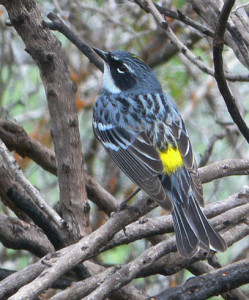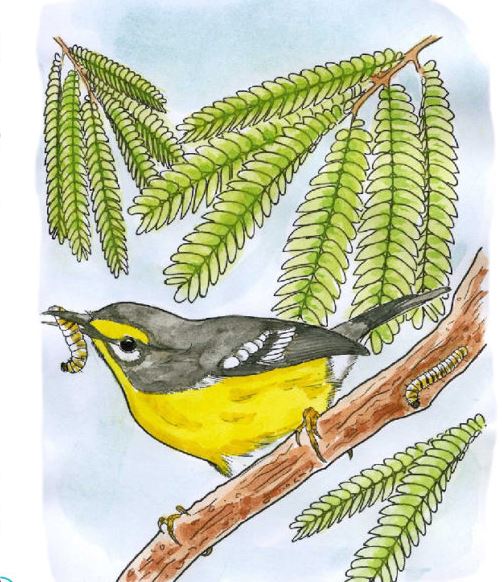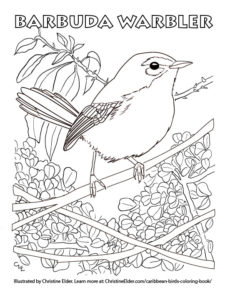By Christine Elder
(Includes tips, videos, resources, and downloadable guides for warbler identification)
Identifying Those Troublesome Warblers!
One of the more challenging bird families to identify is the Parulidae; or New World Wood Warblers. Many, like the common Yellow-rumped Warbler flit about high in the canopy for which birders acquire ‘warbler neck’ from straining upwards to view them. Others, like the Swainson’s Warbler, camouflage themselves in drab plumage and forage silently on the ground in the shadows of the forest’s understory. And most have the annoying habit of jumping about as if they drank way too much coffee, so you can rarely get a good look.

Black-throated Gray Warbler by Christine Elder
As a former birdwatching tour guide, I’ve co-led trips to migration hot spots like Florida and Texas during the height of spring migration, which for the birds involves a dangerous journey across the Gulf of Mexico from their wintering grounds in Central and South America. In these hot spots, one can see a dizzying array of species, including over 20 warblers. So how do I teach folks to identify these challenging birds in the field? Read my tips below to get started!
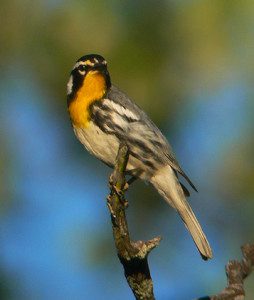
Yellow-throated Warbler
Eye rings, crown stripes, rump patches, oh my!
Identifying warblers, indeed any bird comes down to knowing some basic facts about the species and then observing it closely. With about 111 species in the family, this can be a challenge. A few species don’t look very ‘warblerish’, like the Ovenbird, Waterthrush, and Yellow-breasted Chat, but for the others, you’ll need some additional help.
Color and plumage patterns, voice, behavior, and habitat are the most important characteristics. Armed with the additional knowledge of a species’ geographic range, you will likely be successful. A good field guide is also invaluable (I list my favorites below).

Yellow-breasted Chat
Color
Color patterns may be quite striking, making some species easily recognizable. I will never forget seeing my first Red Warbler on the slopes of the Colima Volcano in Mexico, with its unique white cheek patch against a solid background of fire engine red plumage. Or the Hooded Warbler, with the male’s distinctive warm yellow mask on a black head. But many other warblers are easily confused with their dizzying array of eye rings, crown stripes, streaked breasts, and rump patches. It’s enough to drive you crazy! Luckily, during our Texas excursion, we were viewing the birds at the easiest time of year; during their spring migration, when the males are dressed up in their fanciest attire and are singing their unique, species-specific songs.
Voices include call notes and flight notes, as well as the more unique songs sung so melodiously by the males during the breeding season. Some folks have a better ear for learning to recognize these songs, but for the rest of us, it takes a lot of time and repetition. Studying audio resources helps a lot too (more on that below).
Behavior
Behavior can offer clues to identity as well. Notice if the bird’s gait is hopping, walking, or shuffling. The Black and White Warbler (whom I affectionately call the “barcode warbler” for obvious reasons), has a distinctive foraging habit similar to a nuthatch, creeping headfirst or upside down on trunks and branches. Palm Warblers and Waterthrushes habitually pump their tails as if they’re perpetually off-balance. And the lovely American Redstart exhibits a flashy behavior that includes rapid tail fanning and wing spreading, another species I’ve had the pleasure of observing in its natural habitat.
Habitat
Habitat certainly helps to narrow down a species ID. As the Parulidae family name suggests, most wood-warblers are denizens of the forest – but some prefer conifer forests over deciduous woodlands, while others prefer pine plantations, brushy scrublands, or riparian zones.
For example, if you happen to visit the Texas Hill Country in the spring you may be lucky enough to observe the Golden-cheeked Warbler, whose breeding habitat is restricted to Ashe Juniper and open oak woodlands; a rare habitat type nowadays, which unfortunately makes this species the rarest and most endangered warbler in all of North America. Within a habitat type, notice the microhabitat that your warbler frequents. Waterthrushes are nearly always observed along the edge of a quiet stream or pond, not high in the canopy like other warblers.
Geographic location can really help narrow down an identification. For instance, if you’re in the southwestern U.S. along a desert watercourse in mesquite-dominated shrubland, the Lucy’s Warbler is a safe bet.
Summary of things to notice
Most warblers have a similar body size and shape with a fairly short and slender bill. So your challenge is to notice what is different about them, which mostly comes down to color and behavior.
Coloration and color patterns: Warblers come in two basic varieties; one type is relatively plain brown with some subtle streaking (like ovenbirds and waterthrushes) and the other type is brightly colored and patterned, with varying amounts of yellow, red, blue, white and black (like the Prothonotary Warbler or the Black-throated Blue Warbler). Also, look for the following:
- An eye ring, its color, and whether it is complete or broken
- Stripes around the eye; either through, above, or below the eye
- Patches of color on the cheeks or rump and their color
- Stripes or streaking on the throat or breast
- Wing bars and their color
- Underparts (since that’s the only view you’ll often get of many species who flit quickly about in the treetops!). Notice the colors and patterns on their breast, belly, sides, and undertail coverts.
Anatomy:
- Overall size and shape of body and bill
- Primary projection (or the length of the primaries beyond the tips of the secondaries)
- Length of the tail, and its length beyond the end of the primaries and beyond the end of the coverts
Behavior:
- Is your warbler foraging in the trees or on the ground?
- Does it fan its tail, spread its wings, bob, or ‘wag’ its tail?
- What angle does the bird hold its tail in relation to its body?
- Is the bird’s gait hopping, walking, or shuffling?
- What is the character of its voice, the male’s song, and the call and flight notes of both sexes.

Northern Parula
(All photos above courtesy of Steve Shunk / Paradise Birding Tours)
Endemic Warblers of the Neotropics
Of the ~111 species in the New World Warbler family, only about 53 are found in North America. The balance of species is found only south of the border, being endemic to Central and South America. Many, like the Crescent-Chested Warbler above and the Pink-headed Warbler below (both sketched in Guatemala), are relatively non-migratory and less sexually dimorphic than their northern cousins, with males and females bearing similar plumage to each other and throughout the seasons.
If you are lucky enough to travel in the Neotropics in the wintertime, you’ll be treated to not only the resident endemics but all of ‘our’ North American migrants as well! The Collared Redstart and Slate-Throated Redstarts of Central American highlands (pictured below that I sketched in Costa Rica) are several more examples of endemic, non-migratory warblers you may see in the tropics. Notice the subtle differences between the two. I always find that sketching birds helps me to cement their field marks in my mind and speed up my recognition of tricky species in the future!
I created this fused glass art piece in honor of a Red Warbler I enjoyed viewing during a trip to the Colima Volcanoes area of Mexico. This species, native to just three disjunct mountain ranges in Mexico, is easily recognized by its whitish auricular patch.

Red Warbler sculpture by Christine Elder
Some warblers you’ll see in the Neotropics are simply geographic variations of those familiar to you in North America, like this Goldman’s Warbler; a subspecies of the Yellow-rumped Warbler that I spied in the Guatemalan highlands.
Some Neotropical warblers have particularly restricted ranges, like the Adelaide’s Warbler below that I illustrated for the Endemic Birds of the West Indies coloring book. It lives only on the Island of Puerto Rico along with the Elfin-woods Warbler. An additional 14 or so other warbler species are also found only in the Caribbean, a number on just one island, such as the aptly named Bahama, Barbuda, and St. Lucia Warblers! Such restricted ranges can gratefully make identification much easier!
Challenges of Identifying Out-of-Season Warblers
Just when you thought identifying summer warblers was a challenge, wait til early spring or autumn! That’s when migrating warblers resemble each other even more; with species, ages, and genders looking deceptively similar.
You’ll need to rely less on colorful field marks, and more on subtleties of the birds’ more muted off-season color patterns as described above. Considering behavior, habitat, and range come into greater importance as well. I suggest spending more time in the summer observing females of a species so that you won’t rely on just the ‘wow factor’ of colorful males in breeding plumage. This will help you in the off-season to notice the more subtle characters of both males, females, and juveniles as they come back through your neighborhood on their way to their southern wintering grounds.
Can you guess what species this is by its subtle field marks?
Pleasure without identification
If you’re watching warblers in the autumn, or trying to identify molting males, drab females, nondescript juveniles, or (heaven forbid) hybrid individuals, well the going gets a lot tougher.
You know how kids are always asking you the name of something, but as soon as you tell them, they’re on to the next subject? This can happen to birdwatchers as well. As difficult as it may sometimes be to identify a bird, I suggest you find comfort in the pleasure of simply observing an individual without the obsession of pinning a name on it. Take time to enjoy watching a bird’s behavior; what it’s eating, where it’s foraging, and interactions with other birds in its habitat. Take notes, take photos, and record its voice on your smartphone. Be in the moment with a bird, and you’ll likely learn more about it than if you’d immediately named it and moved down the trail.
Download my Parts of a Bird Cheat Sheet
Since many warblers have a similar body shape, it’s best to focus on a bird’s plumage color and patterns of masks, lines, eye rings, stripes, streaks and spots, and rump and cheek patches. To save you time, I have created a downloadable identification cheat sheet as well as a step-by-step video on sketching warblers below.
Many warblers have complex color patterns, especially on their heads. These patterns often follow the feather groups, for example, a stripe on the crown or a cheek patch on the auriculars, so it’s a good idea to learn the names and placement of these groups. This is two-page Parts of a Bird pdf that includes a blank page for you to color code.
Download my Identifying Warblers in the Field cheat sheet

I have created this handy-dandy infographic for you to download. This Identifying Warblers in the Field downloadable pdf has bird templates for you to sketch on, adding field marks you see in the field, with tips on what to look for on birds to help identify them. Print it out, attach it to a clipboard, and bring some colored pens or pencils with you next time you’re in the field.
Download my Barbuda Warbler Coloring Page for kids
Learn your warblers by sketching them
As you may know, I’m a big proponent of learning by sketching. No matter if you tell yourself you can’t draw a straight line or you haven’t doodled since grade school, and regardless of your results on the paper, just the act of trying to sketch a bird while observing it can have a profoundly positive and long-term effect on your ability to recognize the bird next time you see it.
Since many warblers have a similar body shape, it’s best to focus on a bird’s plumage color and patterns of masks, lines, eye rings, stripes, streaks and spots, rump and cheek patches.
BOOKS
- The Warbler Guide, by Tom Stephenson and Scott Whittle
- A Field Guide to Warblers of North America, by Jon Dunn and Kimball Garrett
- Stokes Field Guide to Warblers, by Donald and Lillian Stokes
- Sibley’s Birding Basics, by David Allen Sibley
- Peterson Reference Guide to Birding by Impression, by Kevin Karlson and Dale Rosselet
- North on the Wing: Travels with the Songbird Migration of Spring, by Bruce Beehler
ONLINE RESOURCES
- Tutorial video on warbler identification by the Cornell Lab of Ornithology
- Cornell Lab of Ornithology Birds of the World website
- Madison Audubon Beginner’s Guide to Fall Warblers
- Identifying Warblers in the Caribbean of the BirdsCaribbean website
- Downloadable ‘cheat sheets’ on warbler identification from The Warbler Guide
- ID Tip: Blackpoll vs. Bay-breasted Warbler in Fall
- The Warbler Guide App for iPhone and iPads
- Songs of the Warblers of North America (see description below)
Songs of North American Warblers
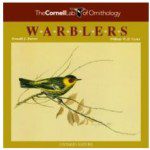 Learning to confidently identify warblers really comes down to learning their songs and calls. With their skulky behavior and habit of staying high in the treetops, warblers often only reveal their true identities by their voices. Listening to and memorizing them can easily be accomplished nowadays with readily available high-quality audio compilations professionally recorded in the field. The Songs of the Warblers of North America is one such resource; available as an mp3 downloadable audio guide with accompanying photographs, it includes 311 recordings covering 57 warbler species. The audio guide can be purchased from the online store of the Macaulay Library of the Cornell Lab of Ornithology.
Learning to confidently identify warblers really comes down to learning their songs and calls. With their skulky behavior and habit of staying high in the treetops, warblers often only reveal their true identities by their voices. Listening to and memorizing them can easily be accomplished nowadays with readily available high-quality audio compilations professionally recorded in the field. The Songs of the Warblers of North America is one such resource; available as an mp3 downloadable audio guide with accompanying photographs, it includes 311 recordings covering 57 warbler species. The audio guide can be purchased from the online store of the Macaulay Library of the Cornell Lab of Ornithology.
Download my Wilson’s Warbler photo collage

Related Bird Resources on this Website
Here are some more stories, videos, and bird sketching resources I’ve written.
World Migratory Bird Day and Why Birds Migrate
Birds of the Neotropics (Videos)
My Costa Rica Birding Big (sketching) Day
A Global Big Day in Costa Rica
A Black-headed Grosbeak Nest (video)
LEARN TO IDENTIFY AND SKETCH BIRDS
My course, Sketching Backyard Birds for Beginners, is a comprehensive course on common bird families and how to learn about them through drawing them.


